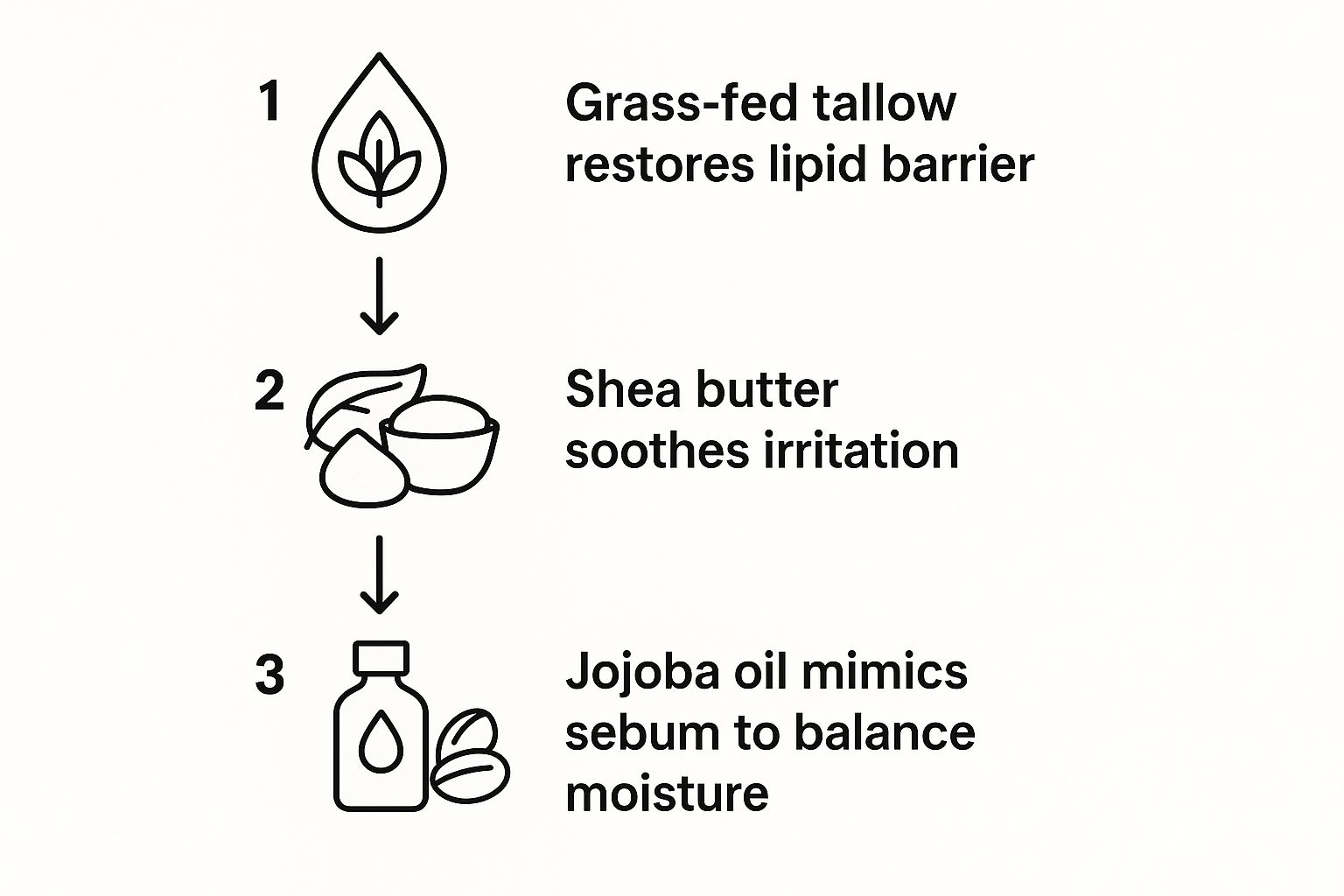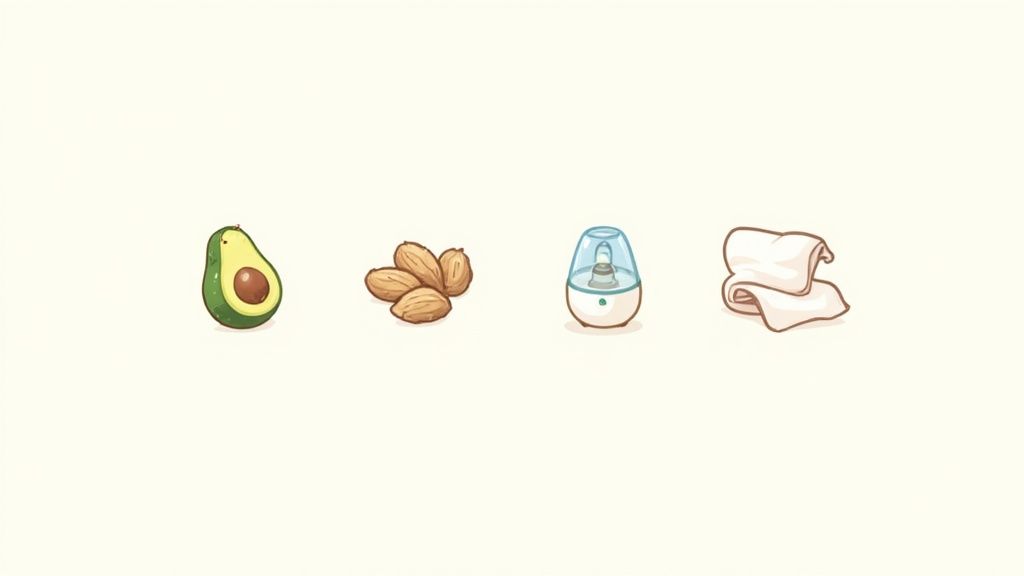If you're slathering on moisturizer all day long but still battling tight, flaky skin, the problem probably isn't a lack of cream. The secret to a truly effective natural dry skin treatment is to go deeper—repairing your skin’s own protective barrier and tackling the root causes, not just putting a temporary band-aid on the symptoms. This is how you find lasting comfort and a healthy glow.
Why Your Skin Is Still Dry Despite Your Efforts

It's an incredibly frustrating cycle, isn't it? You apply lotion, feel some relief, but an hour later, that familiar tightness and flakiness creep back in. This happens when your skin's natural moisture barrier—a critical shield made of oils and lipids—is damaged.
Imagine it like a brick wall. When the mortar between the bricks starts to crumble, the wall becomes weak and leaky. For your skin, this means precious moisture escapes easily, and irritants can get in.
This barrier breakdown is rarely a single-cause issue. It's usually a perfect storm of factors that work together to prevent your skin from holding onto the hydration it so desperately needs.
Identifying Your Dry Skin Triggers
Getting to the bottom of what's causing your dryness is the first real step toward a solution that actually works. Let's look at some common culprits behind that persistent dryness.
Many things can contribute to a compromised skin barrier. The dry air from your indoor heating, biting winds, and too much sun are all classic environmental stressors that suck moisture right out of your skin.
But it’s not just about what’s happening on the outside. Internal factors like your diet, how much water you drink, and even hormonal changes can have a massive impact on your skin's health from the inside out. And of course, many popular cleansers and skincare products are loaded with harsh sulfates and alcohols that strip away the very oils your skin needs to protect itself.
This widespread struggle is why the global market for flaky skin treatment is expected to hit USD 6.4 billion by 2035. It's a huge jump, and it shows that people are looking for real answers.
This trend highlights a growing awareness that genuine healing comes from ingredients that support the skin's natural functions, not fight against them. By figuring out your personal triggers, you can start building a routine that uses nutrient-rich, natural ingredients to truly restore your skin.
Using gentle, lipid-rich formulas is key to rebuilding that barrier, which is why we’re so passionate about the unique benefits of beef tallow for skin.
Choosing Nature's Most Powerful Moisturizers
When you're trying to find a natural solution for truly dry skin, it's easy to get lost in a sea of ingredients. The secret isn't just finding something that's "natural," but finding something that works with your skin's own biology. You need moisturizers that do more than just coat the surface; they need to sink in and help your skin heal itself.
This is where grass-fed tallow really shines. It's incredibly biocompatible, which is just a technical way of saying your skin recognizes it and knows what to do with it. The fatty acids and rich lineup of vitamins—A, D, E, and K—are almost identical to the lipids found in healthy skin. Because of this, it absorbs deeply to repair your skin barrier from the inside out, providing genuine relief instead of a quick, temporary fix.
If you want to dive deeper into this, we've got a whole guide on how an organic tallow face cream can support your skin's health.
The Power Trio for Skin Restoration
As amazing as tallow is on its own, its healing power gets a serious boost when combined with the right botanicals. Think of them as a team working together.
Shea butter is a classic for a reason; it's fantastic for calming the redness and irritation that almost always comes with seriously dry, unhappy skin. Then you have jojoba oil, which is a master of balance. Its structure is so close to our skin's natural sebum that it helps regulate moisture without clogging pores.
This infographic breaks down how these ingredients team up to bring your skin back to life.

You can see how each one has a specific job, but they all support the same goal: complete skin restoration. It's this kind of smart, synergistic approach that explains why so many people are moving toward cleaner, more effective skincare. In fact, the U.S. natural skincare market is growing by 6.7% every year, all because people want ingredients that are both safe and deliver visible results.
Key Takeaway: The best natural moisturizers are the ones that mimic your skin's own makeup. By combining grass-fed tallow, shea butter, and jojoba oil, you get a powerful, all-in-one solution that rebuilds the skin barrier, calms irritation, and locks in moisture for relief that actually lasts.
Building Your Daily Dry Skincare Ritual

Putting together a routine that actually helps dry skin isn't about adding a dozen complicated steps. The real secret is creating a simple, consistent ritual that protects your skin during the day and helps it repair while you sleep.
It all comes down to small, impactful habits. For instance, always use lukewarm water instead of hot—that steamy shower might feel good, but it's stripping away your skin’s precious natural oils. Another game-changer? How you dry your face. Gently patting with a soft towel is so much kinder to a fragile skin barrier than aggressive rubbing.
Your Morning Protection Routine
In the morning, the goal is simple: hydrate and protect your skin for the day ahead. Honestly, for many people with very dry skin, a full-on cleanse first thing can do more harm than good.
- A Gentle Rinse: Just start with a splash of lukewarm water. This is enough to refresh your skin without stripping away the protective oils your body produced overnight.
- Lock in Moisture: While your skin is still a little damp, grab a pea-sized amount of a nourishing balm like Wild Tallow’s Whipped Tallow Cream. Applying moisturizer to damp skin is a pro-tip—it helps seal in that surface-level hydration, keeping you comfortable for hours.
This quick two-step process creates a breathable shield against the elements, keeping your skin soft and resilient all day long. It's minimalism that really works.
Your Evening Repair Ritual
Nighttime is when your skin gets to work healing and regenerating. Your job is to gently clear away the day’s grime and then load it up with deep, restorative nourishment.
A proper evening cleanse is non-negotiable. You need to get the dirt and environmental buildup off, but without wrecking your skin barrier in the process. I always recommend an oil-based cleanse or a very gentle, non-foaming wash for this.
After cleansing and patting your skin almost dry, it's time for a richer application of your moisturizing balm. This is the moment to give your skin everything it needs to repair itself overnight. If you're new to using such nutrient-dense balms, our guide on how to use tallow has some great tips for getting the most out of it. Don't be afraid to apply a slightly more generous layer at night to support that natural healing cycle.
Key Insight: Consistency is everything. If you commit to this gentle morning and evening routine for at least one full skin cycle—that’s about 28 days—you give your skin barrier the time it actually needs to rebuild. This patient approach is what leads to lasting relief from dryness.
Holistic Habits for Hydrated Skin

If you really want to beat dry skin for good, your approach needs to go beyond just what you smooth onto your face. Think about it: if your daily habits are constantly working against you, your moisturizer is always fighting an uphill battle.
The goal isn't just to slather on a temporary fix. It's about creating an environment—both inside your body and in your home—where your skin can actually heal itself and hold onto precious moisture. These small, consistent shifts are what build a true foundation for hydrated, healthy skin.
Nourish Your Skin from the Inside Out
You can’t build a strong house with flimsy materials, and the same goes for your skin barrier. That barrier is made of lipids (fats), so what you eat directly impacts its strength and ability to lock in moisture.
This is where healthy fats become your skin's best friend. I'm talking about things like adding half an avocado to your salad or snacking on a handful of walnuts. These foods are packed with omega-3 and omega-6 fatty acids, which are the literal building blocks your body needs to fortify that all-important barrier. Drizzling a good olive oil on your veggies is another easy win for skin elasticity.
It’s a simple concept: you’re not just coating a weak barrier from the outside; you're building a stronger one from within.
Adjust Your Environment for Better Skin
The world around you can be surprisingly harsh on your skin, but a few simple tweaks can turn your home into a hydration sanctuary. You have more control here than you might think.
Here are a few practical changes that make a huge difference:
- Bring in a Humidifier: Especially in dry winter months or arid climates, a humidifier is non-negotiable. It puts moisture back into the air, so the air stops stealing it from your skin.
- Be Mindful of Fabrics: Scratchy wool sweaters might be cozy, but they can physically irritate already-compromised skin. Whenever possible, choose soft, breathable fabrics like cotton or bamboo for clothing and bedding that touch your skin directly.
- Rethink Your Detergent: The fragrances and chemicals in many laundry detergents are common culprits for irritation and dryness. Switching to a fragrance-free, hypoallergenic formula is one of the easiest and most effective changes you can make.
Expert Tip: Your shower routine is a big one. That long, steaming hot shower feels amazing, but it's one of the fastest ways to strip your skin of its natural oils. Keep the water lukewarm and the time short to prevent that tight, itchy feeling afterward.
Common Mistakes in Natural Skincare to Avoid
When you're trying to find the perfect natural dry skin treatment, it’s easy to get a little too enthusiastic and make a few common missteps. I've seen it time and time again.
One of the biggest culprits? Over-exfoliating. It feels like you're scrubbing away the problem, but when your skin's barrier is already compromised, harsh scrubs or strong acids just create more irritation and strip away what little moisture you have.
Another trap is thinking that if an ingredient is "natural," it must be gentle. That's not always the case. Potent essential oils, for instance, can be surprisingly irritating, especially when they aren’t properly diluted. Just because something comes from a plant doesn't mean it's right for your reactive skin.
Don't Skip the Smart Steps: Patch Testing and Sticking With It
This brings me to something that really isn't optional: the patch test. Before you get excited and apply a new product everywhere, test a small amount on your inner arm or behind your ear. Give it 24-48 hours. This one simple step can save you from a world of redness and frustration.
The other thing I can't stress enough is consistency. Natural skincare isn't a quick fix; it works with your skin's own healing rhythms. If you give up on a new routine after just a week, you'll never see what it's truly capable of.
You have to commit to a routine for at least one full skin cycle—that's about 28 days—to see real, lasting changes in your skin's health and hydration.
This mindset shift is why the natural skincare world is growing so rapidly. The global organic skin care market was valued at an incredible USD 12.57 billion in 2024, driven by people looking for solutions that truly work. You can find more details about this trend on Straits Research. It all comes down to patience and finding the right ingredients for your skin.
Got Questions About Going Natural for Dry Skin? We Have Answers.
Switching up your skincare routine always comes with a few questions. It's totally normal. Getting clear, honest answers will help you feel good about the products you're putting on your skin and the routine you're building.
How Quickly Will I See a Difference?
You'll probably notice your skin feels less tight and more comfortable right away. That immediate relief is wonderful, but the real magic—repairing your skin's barrier—takes a little more time.
Give it about 2-4 weeks of consistent, daily use. That's when you'll start to see a real shift in your skin's texture and how well it holds onto moisture.
Here's a pro-tip: Your skin naturally renews itself every 28 days or so. Natural ingredients work in sync with that cycle. If you can stick with your new routine for at least a month, you’ll give your skin a full cycle to heal and really see those lasting results.
Can I Use Natural Balms if My Skin is Prone to Breakouts?
Absolutely. In fact, it can be a game-changer. So much of what we call "acne-prone" skin is actually just a damaged moisture barrier trying to fix itself by pumping out excess oil.
The key is using the right kind of balm. Grass-fed tallow is incredible for this because its fatty acid profile is almost identical to our own skin's sebum. That similarity means it's far less likely to clog your pores. Just start with a tiny amount—a little goes a long way—and see how your skin responds.
Ready to give your dry skin the simple, powerful nourishment it's been craving? Discover the restorative benefits of Wild Tallow Skincare and begin your journey back to healthy, happy skin.

